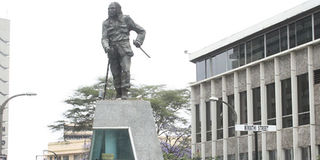Celebrate real freedom heroes

A statue of Dedan Kimathi, one of Kenya's freedom fighters, on Kimathi street, Nairobi.
It has been a long, arduous three decades since the so-called Second Liberation happened and most of the men and women once dubbed “Young Turks” are now old.
What is undisputable is that few of the stalwarts of the struggle for political pluralism ever enjoyed the fruits, lending credence to the truism that those who hunker down in the trenches are rarely the ones who enjoy the spoils.
This injustice has happened in this country before; the offspring of those who fought for independence in the forests remain dispossessed to this day, while those of collaborators with colonialists live in obscene opulence.
Today, we can say that the ideals for which these folks fought have only been partially fulfilled, as the value of their sacrifices was gradually eroded until, at least, 2010 when a new constitutional dispensation came into being promising comprehensive reforms in most institutions of governance.
The new document seemed to be what Kenyans had been yearning for all those years: it was pregnant with promise of a better tomorrow for everyone, a life of plenty untainted by the stench of uncontrollable corruption, executive excesses, bent Judiciary and ravenous legislators.
The spectre of extra-judicial executions, privatised insecurity, and generalised deprivation were to be things of the past. It was a document in which the private citizen was promised all the inalienable rights that had been denied by past regimes, and one in which individuals were free to make their political choices unhampered by enforced servility to the powers-that-be.
In short, it was to be a democratic society organised by a democratic government whose legitimacy was beyond question because it was freely elected by the majority.
Very few of those things came to be. After a relatively short period, it became clear that old habits die hard and the country was once again in the stranglehold of successive regimes that were intent on watering down most of the gains of the 2010 Constitution.
This means that all the sacrifices made by the indefatigable constitutional warriors may have been in vain. Without these people, not only would Kenya still be under the grip of a monolithic ruling party, it would be under a full-blown dictatorship.
On Monday, Kenyans will observe the 59th Jamhuri Day with pomp and circumstance. This is the day Kenya became a Republic with a brand new constitution that gave great hope to millions.
Less than 15 years later, the Independence Constitution had been so watered down through amendments as to be unrecognisable. The changes gave the presidency so many tyrannical powers that the very constitution became a heavy yoke around the necks of Kenyans.
In a way, Mzee Jomo Kenyatta was a benevolent dictator as was his successor, President Daniel arap Moi.
However, something happened four years into Moi’s rule that turned him into a cruel despot: a group of soldiers tried to overturn his government, the coup bid was crushed, detention-without trial became his favourite modus operandi to contain dissent, and the Constitution was amended by a subdued Parliament to make Kenya a de jure single-party dictatorship.
A few years later, the winds of change towards political pluralism had started blowing all over the world and those Kenyan politicians who had suffered at the hands of an intolerant Kanu behemoth coalesced around the idea of change, joined hands with lawyers, clerics, university lecturers and journalists to demand expended democratic space.
In a sense, expelling people from Kanu was self-defeatist, for it hastened the agitation for multipartyism. Before even that, of course, were the infamous Mwakenya trials, torture, and executions which made ending Kanu rule an imperative.
This agitation was responsible for giving prominence to many Kenyans, some of whom took recourse in law - the likes of James Orengo, Gibson Kamau Kuria, John Khaminwa, Gitobu Imanyara, Paul Muite, Kiraitu Murungi, Martha Karua, Maina Kiai, Kivutha Kibwana, Wachira Maina, Kioko Kilukumi, Willy Mutunga, and, yes, the current Chief Justice, Martha Koome.
The politicians among them were Kenneth Matiba, Charles Rubia, Raila Odinga, George Anyona, Masinde Muliro, Martin Shikuku, Khalid Balala, Salim Bamahriz, and a few other souls, now departed.
As for the clerics, one can never forget the works of Bishop Alexander Muge, Bishop Henry Okullu, the Rev Timothy Njoya, and Archbishop Ndingi Mwana a’Nzeki. Nor should we forget all the intellectuals who lost their liberty for the cause, and they are too many to name here.
All one can say is that these intrepid souls ought to be the ones being celebrated during national holidays like Jamhuri, but, sadly, this won’t happen, for these honours have become the preserve of charlatans. Nevertheless, the struggles ought to tell the present generation of Kenyans something. Freedom and liberty and are never handed to anyone on a platter; they are earned.
The majority of Kenyans have no idea what the struggle of the 1980s and early 1990s was all about. The problem is not that they were too young to know; the problem is that they don’t want to know, and as the adage goes, those that fail to learn from history are doomed to repeat it. The question now remains: who will fight for them?
Mr Ngwiri is a consultant editor; [email protected]





